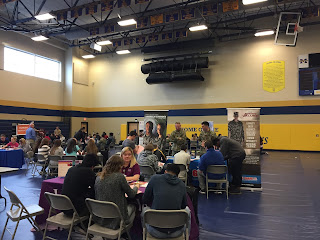The weekend of March 15th-18th
heralded the 2018 Middle Atlantic Archaeology Conference where our very own Dr.
Kurt W. Carr received the Lifetime Achievement Award. This award recognizes an
archaeologist who has made significant contributions for more than 20 years to
archaeology in the Middle Atlantic Region. The recipient must meet four
criteria of Ethics, Research, Outreach and Service. We would like to take this opportunity to
congratulate Kurt and honor his ongoing contributions to Pennsylvania and North
American archaeology. As a staff archaeologist with the Pennsylvania Historical
Museum Commission (PHMC) for 38 years, we also celebrate his contributions to the
Pennsylvania Archaeology Site Survey (PASS),
and encourage all to attend next week’s Pennsylvania Archaeology Council
Symposium, Archaeologists Have History Too: Oral
History of Pennsylvania’s Archaeology Site Survey.
Kurt began his career path as an
archaeologist in high school at the age of 16, hitchhiking each summer from the
northern suburbs of Philadelphia to join Fred Kinsey’s Franklin and Marshall College
field school and survey crew in the Upper Delaware Valley. He continued his
education with Dr. Kinsey, earning his B.A. in Anthropology from F&M in
1971, then branched out to earn his masters and doctorate degree in
Anthropology from The Catholic University of America in 1975 and 1992. His
graduate studies focused on Paleoindian and Early Archaic prehistory at
Thunderbird and Fifty sites in Virginia. As a professional archaeologist, his
post-graduate research and scholarship has broadened and continued in the areas
of early hunting and gathering cultural adaptations, stone tool technology,
settlement pattern analysis, geomorphology and environmental reconstruction.
He started his career at the
Pennsylvania Historical Museum Commission (PHMC) as a cultural resource
reviewer in 1980, eventually heading and overseeing the expansion of the
department as the Chief of the Division of Archaeology and Protection from 1988
to 2005. He became the Senior Curator of the Section of Archaeology at The
State Museum in 2007. Beyond his duties as a state archaeologist, Dr. Carr has
served as a mentor to students of archaeology; taught courses at local
community colleges; chaired committees and served in various leadership
capacities for archaeology societies, councils and conferences; helped to
organize annual meetings; delivered over 50 papers; and published over 25 peer
reviewed journal articles and books, as well as over 13 technical reports.
One of Kurt’s many contributions
to the archaeology of Pennsylvania is his participation in regional and
statewide surveys as a college student and later as a PHMC archaeologist. State
Museum archaeologists drafted the first standards, known as the PASS file, to record
archaeological resources systematically in the 1950s. This ongoing statewide campaign has recorded
over 22,000 historic and prehistoric sites in the Commonwealth through the
efforts of professional archaeologists from government, private and academic
institutions, as well as avocational chapter members of The Society for
Pennsylvania Archaeology (SPA). Kurt has many on-the-ground stories to share
from his college days of paddling the tributaries of the Susquehanna with a
fellow student testing for, and recording sites on the floodplain. Not to
mention, the months going door-to-door collecting landowner interviews in Lancaster
County. He is also a wealth of knowledge from years spent guiding professional
and avocational archaeologists through the site recording process.
Next weekend attendees of the
Pennsylvania Archaeology Conference (PAC) Symposium will have the opportunity
to hear Kurt’s experiences along with a comprehensive panel of Pennsylvania
archaeologists whom have also devoted a lifetime of work toward creating and
updating the PASS file system. Other representatives from the PHMC who are
participating will be Noel Strattan, State Historic Preservation Office (SHPO)
CRGIS Coordinator as well as Section of Archaeology staff member, Jim
Herbstritt along with former Senior Curator, Barry Kent. Speaking of lifetimes,
it is a once in a lifetime opportunity to hear an oral history of the
Pennsylvania Archaeology Site Survey as well as learn about current archaeology
projects happening in the state at The Society for Pennsylvania 89th
Annual Meeting to follow.
The Pennsylvania
Archaeology Conference Symposium and
The Society for
Pennsylvania 89th Annual Meeting
April 6-8th,
hosted this year by North Fork Chapter 29
Comfort Suites
10 Lakeside Avenue
Dubois, PA 15801
(814) 375-6028
The PAC symposium will kick off
the weekend long conference on Friday afternoon. Saturday through Sunday
morning, paper sessions begin with the SPA annual meeting. Representing the
SHPO, Hannah Harvey will present during the Saturday morning session, The South Blairsville Industry
Archaeological District: Exploring Western Pennsylvania’s Plate Glass Heritage.
Past and present State Museum affiliated presenters include Barry Kent and Jim
Herbstritt, who will be delivering concurrent papers to start the Saturday afternoon
session—Images of Artifacts of
Pennsylvania’s Past from Paleoindian to Historic Times, and Ethnogenesis and the Beginnings of
Susquehannock. You can find further details at the SPA
website, and link to the Preliminary
Program for a complete listing of speakers and topics.
Walk-in registration is welcome
at the door and there is still time to mail-in
or register online for this year’s PAC Symposium and SPA Annual Meeting. Registration
fees increase to $35.00 for regular SPA members and $25.00 for students as of
this Saturday, March 31, 2018. Banquet fees remain at $32.00, for
pre-registration and with limited availability for walk-in registrants. This
year’s keynote banquet speaker is Dr. Michael Gramly, presenting Ritual Hunting of Proboscideans in the New
World: Its Character, Inception, and Disapperance. Those interested in
hotel reservations can reserve directly with the Comfort Suites. Reduced room rates
are no longer available for conference attendees.
For more information, visit PAarchaeology.state.pa.us or the Hall of Anthropology and Archaeology at The State Museum of Pennsylvania .











